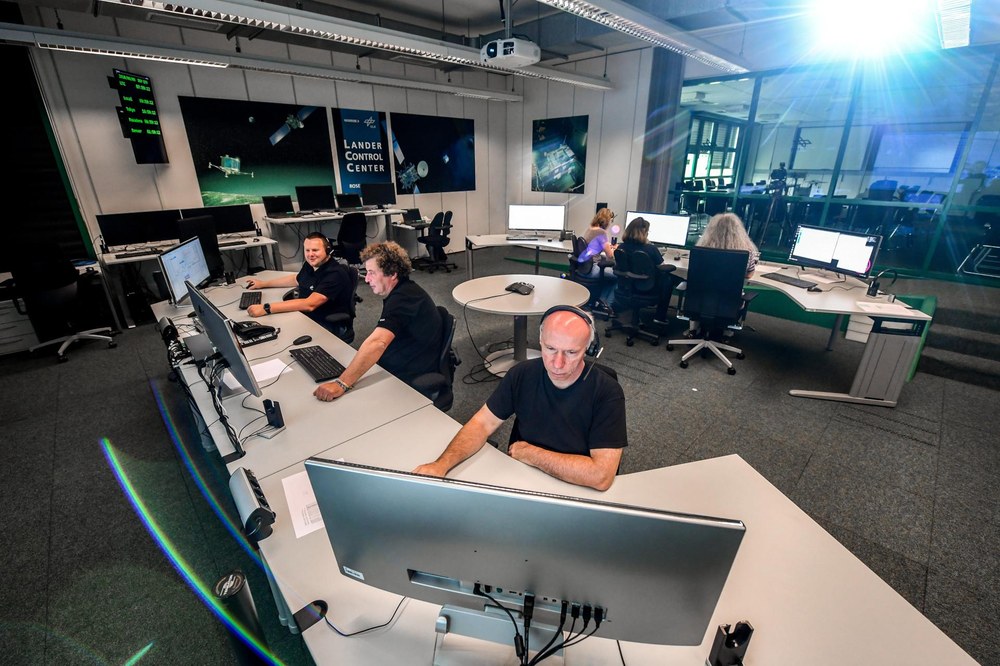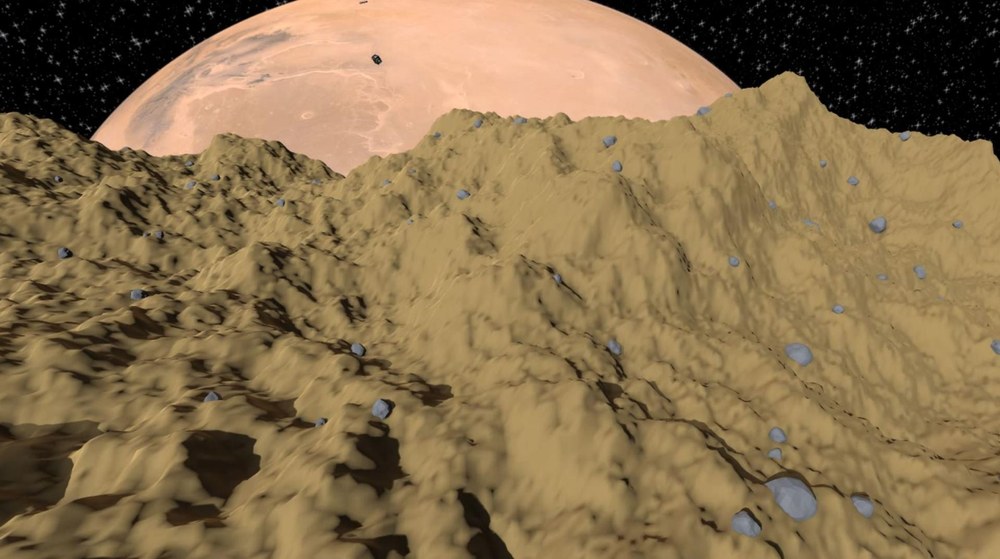The German rover control centre

Operating landers on the surfaces of planets and other celestial bodies is a particularly challenging aspect of space exploration. DLR's Microgravity User Support Center (MUSC) has unique experience in this field in Europe. The first comet lander, Philae, and the asteroid lander, MASCOT, were operated from the MUSC control centre in Cologne. MUSC was also responsible for operating the Heat Flow and Physical Properties Package (HP³), an instrument developed at DLR that was part of the NASA/JPL InSight mission. These activities have enabled further mission opportunities, continuing the on-site exploration of the small bodies in the Solar System – asteroids and comets – as well as further developing landing technologies for missions to moons and planets.
Detailed planning for all mission phases
The Martian Moons eXploration (MMX) rover mission presents a major operational challenge. For the first time, a lander is to be placed on a martian moon. Also, for the first time, a rover is to be operated on a celestial body with a very low gravitational field – Phobos. This moon is a world that is largely unknown. Intensive and extensive preparations are needed to realise this mission. The ground control facilities are already available to provide support during the testing phases on Earth. The main focus before launch is on the preparation of the flight phase to the Mars system as well as the pre-planning of the actual 'on-Phobos' phase.
Both during the flight and on Phobos, command and data transmission will be carried out via the MMX mothercraft, which will act as a communications relay. Data will first be received by the Japanese ground segment and then transmitted to Europe for analysis. During the on-Phobos phase, there will normally be one ‘communications pass’ between Earth and the mothercraft each Earth day. Commands will be transmitted, and data received during these passes. The mothercraft will contact the rover on the surface of Phobos when it is within line of sight. With this arrangement, the rover’s status analysis, and also the results of the experiments or the driving behaviour can only be evaluated after a long delay. This requires precise planning and control of the rover activities and commanding.
During the flight to the Mars system, checkouts and in-flight calibrations will be conducted. In addition, maintenance work will be carried out on the battery in order to have the best possible power capacity available after landing in the harsh conditions on Phobos. In-flight activities will be scheduled every three months, with a detailed preparation and testing phase implemented in advance.
The great unknown – the landing site
The landing site can only be selected after reaching the Mars system, once the first detailed images of the martian moon have been acquired and analysed. Precise knowledge of the rover's environment will only be available after landing. This poses major challenges for operations planning, particularly for commanding the rover. In the lead-up to the on-Phobos phase, the rover activities will be planned in the control centres to make the best possible use of the available power. The possibilities for data transfer to Earth will need be taken into account in order to be able to make the necessary decisions in the control centres at predetermined times. Planning activities will also have to be coordinated with regard to the thermal conditions on Phobos and the needs of the rover.
In addition, various scenarios with different power availability, thermal conditions and data transmission rates will be simulated during preparations for landing, including the analysis of possible non-nominal cases. The necessary command products for the envisaged conditions and procedures will be developed and tested on Earth. When the rover’s on-Phobos phase begins, everything will be as well-prepared as possible.
The landing on the surface of Phobos will be one of the most difficult challenges during this mission. JAXA will manoeuvre the mothercraft to just above the surface and then deploy the rover. The rover will then slowly descend to the surface, bounce after a soft impact and come to rest. It will then correct its orientation and unfold its solar arrays. This is a critical moment; if the rover cannot deploy its solar arrays, it will not be able to recharge its batteries for future activities. At this point, it will not be possible to intervene in the process from the ground because the mothercraft, which acts as the communications relay, will not be in line of sight of the rover.

Animation: MMX rover descending towards the Phobos surface
Your consent to the storage of data ('cookies') is required for the playback of this video on Quickchannel.com. You can view and change your current data storage settings at any time under privacy.
After landing, commissioning of the rover will be carried out. The individual subsystems and experiments on the rover will be carefully checked. The cameras will provide the first detailed information about the terrain in which the rover is located. During commissioning and initial experiments, detailed preparations for the first driving tests will be carried out in parallel.
Reliable infrastructure as the mainstay of the control centres
The rover will be operated from two control centres, one in France, at the Centre national d'études spatiales (CNES), and one at DLR (MUSC). The control centres will take turns operating the rover. While one control centre will actively implement commanding on the martian moon, the other control centre will carry out detailed planning and optimisation activities for the next mission phase.
During the 100-day mission, the rover’s data will be analysed daily, and commands sent to the rover if necessary. The team will have to adapt the pre-planned rover activities to match the developments on Phobos and take corrective actions if necessary. Due to the time delay between the transmission of commands and the receipt of the resulting data, the team has to plan the rover activities in great detail and several days in advance. The teams will not have a livestream of the rover status available; instead, they will only have a time-delayed, earlier status.
Special attention is also being paid to the infrastructure serving the control centres. This must be reliable and meet all the mission requirements. The interfaces must be prepared and fully functional. This infrastructure is the mainstay of the control centres, which will make the demanding operation of the rover possible in the first place. A well-thought-out design of the control centres, reliable tools and intensive testing of the facilities, the processes and training of the teams is therefore indispensable.
The team is made up of the most diverse professional groups: engineers, computer scientists, researchers, technicians and administrators.
MMX – Martian Moons eXploration
MMX is a mission of the Japanese space agency JAXA with contributions from NASA, ESA, CNES (the French space agency) and DLR. CNES (Centre National d'Études Spatiales) and the German Aerospace Center (Deutsches Zentrum für Luft- und Raumfahrt; DLR) are jointly contributing a 25-kilogram rover to the Martian Moons eXploration Mission (MMX). The Franco-German MMX rover is being designed and built under the joint leadership of CNES and DLR. In particular, DLR is responsible for the development of the rover's landing gear, including the lightweight body, as well as the entire uprighting and locomotion system. DLR is also contributing the connection adapter to the MMX spacecraft and providing a Raman spectrometer and a radiometer as scientific experiments. These will analyse the surface composition and texture on Phobos. CNES is making significant contributions with camera systems for spatial orientation and exploration on the surface, as well as for the study of mechanical soil properties. CNES is also developing the rover's central service module, including the on-board computer and the power and communications system. After the launch of the MMX mission, the rover will be operated by CNES control centres in Toulouse (France) and DLR in Cologne (Germany).
For DLR, the institutes of System Dynamics and Control, Composite Structures and Adaptive Systems, of Space Systems, of Optical Sensor Systems, of Planetary Research, for Software Technology and the Microgravity User Support Center (MUSC) are also involved under the leadership of the DLR Institute of Robotics and Mechatronics.
The MMX mission is a continuation of an already long-standing successful cooperation between JAXA, CNES and DLR. It builds on the previous mission Hayabusa2, in which JAXA sent a spacecraft to the asteroid Ryugu with the German-French MASCOT lander on board. On 3 October 2018, MASCOT landed on Ryugu and sent spectacular images of a landscape ridden with boulders and rocks, and virtually no dust. Hayabusa2 collected samples from Ryugu and brought them to Earth on 6 December 2020.
